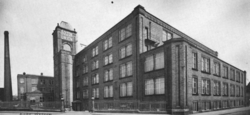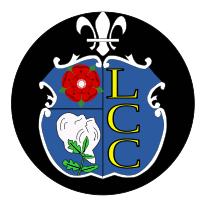Bolton Union Mill, Bolton
 | |
 | |
| Cotton | |
|---|---|
| Spinning (ring mill) | |
| Location | Bolton |
| Further ownership |
|
| Coordinates | 53°35′00″N 2°26′15″W / 53.5834°N 2.4375°W |
| Construction | |
| Floor area | 15,466.00 |
| Power | |
| Engine maker | John Musgrave & Sons |
| Engine type | tandem compound engine |
| Valve Gear | Corliss valves |
| rpm | 50 |
| Flywheel diameter | 32ft |
| No. of ropes | 28 |
| Equipment | |
| Mule Frames | 40's-50's counts |
| References | |
| [1] | |
Bolton Union Mill, Bolton was a cotton spinning mill in Bolton, Greater Manchester. It was built in 1875 and 1880. It was taken over by the Lancashire Cotton Corporation in the 1930s and brought back into production. Subsequestly it passed to Tootalls and Dewhurst Dent in 1964. Production finished in 1967.
History
Bolton was a mill town; textiles have been produced in Bolton since Flemish weavers settled in the area during the 15th century, developing a wool and cotton weaving tradition. The urbanisation and development of Bolton largely coincided with the introduction of textile manufacture during the Industrial Revolution. It was a boomtown of the 19th century and at its zenith, in 1929, its 216 cotton mills and 26 bleaching and dying works made it one of the largest and most productive centres of cotton spinning in the world.
No1 Mill Built was built in 1875, and No2 Mill was built in 1880. a further site was operated from 1884 by John Hebden and Son, Vernon Mills. The Bolton Union Spinning Company Co Ltd was constituted in 1874 and was operating the mills in 1900. Mill No3 was built in 1902 - 1905. It is not recorded when production stopped.[2]
The industry peaked in 1912 when it produced 8 billion yards of cloth. The Great War of 1914–18 halted the supply of raw cotton, and the British government encouraged its colonies to build mills to spin and weave cotton. The war over, Lancashire never regained its markets. The independent mills were struggling. The Bank of England set up the Lancashire Cotton Corporation in 1929 to attempt to rationalise and save the industry.[3] Bolton Union Mill, Bolton was one of 104 mills bought by the LCC, and one of the 53 mills that survived through to 1950. LLC received permission to re-open the mills in 1946 but in 1961 the mills were bought by Barlow & Jones and Mill No1 demolished. In 1976 the other mills were closed by Tootals Ltd. In 1985 No1 Mill site was landscaped for use as playing fields and No2 Mill was used by Dewhurst Dent Holdings Ltd, G & R Dewhurst (CMT) Curtains Ltd, Dewhurst Printing Company.[2]
The mill is to be demolished (2008) and replaced with apartments, the reason given by the council is the mill no longer reflects the image of the surrounding area.[2]
Architecture
Power
Driven by 1200 hp tandem compound engine by John Musgrave & Sons, operating at 100psi. It had a 32-foot flywheel with 28 ropes, operated at 50rpm. The cylinders, 28"HP, 52"LP had a 6-foot stroke. The air pump was driven from the crosshead. [4]
Owners
- John Hebden and Son, Vernon Mills
- The Bolton Union Spinning Company Co Ltd
- Lancashire Cotton Corporation (1930's-1964)
- Tootals
- Dewhurst Dent
See also
- Textile manufacturing
- Cotton Mill
| ||||||||||||||||||||||||||||||||||||||||||||
References
- ↑ LCC 1951
- ↑ 2.0 2.1 2.2 David Dixon. "Bolton Union Mills (union, vernon, hebden mills)". St Mark's School, Bolton site. Retrieved 8 Nov 2009.
- ↑ Dunkerley
- ↑ Roberts 1921
Bibliography
- Dunkerley, Philip (2009). "Dunkerley-Tuson Family Website, The Regent Cotton Mill, Failsworth". Retrieved 2009-01-09.
- LCC (1951). The mills and organisation of the Lancashire Cotton Corporation Limited. Blackfriars House, Manchester: Lancashire Cotton Corporation Limited.
- Roberts, A S (1921), "Arthur Robert's Engine List", Arthur Roberts Black Book. (One guy from Barlick-Book Transcription), retrieved 2009-01-11
External links
| Wikimedia Commons has media related to Textile mills in Greater Manchester. |

